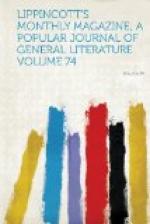The Temple has been for generations a favorite abode with men of letters and others having no leaning toward or connection with the bar. It is a vast bachelors’ hall. Fleet Street and its immediate vicinity is the centre of the publishing interest of London. Here many of the great dailies are edited and printed, and “Brain Street,” as George Augustus Sala fitly nicknamed it, is midway between the “city” and the “West End, “—the “down town” and the “up town” of London, if such a simile is permissible as applied to a brick-and-mortar polypus whose members radiate toward every point of the compass. No part of the Temple is more than five minutes’ walk from this centre of intellectual industry, and yet, once within its walls, the silence and seclusion are complete. The roar and rattle of Fleet Street and the Strand might be a thousand miles away, for scarce a murmur penetrates beyond the Temple gates. The quiet, stone-paved courts, the grassy nooks gemmed with a few choice blossoms, the soft-plashing fountains, overshadowed by sturdy elm-, plane-, or fig-trees, the cool stone archways leading from one court to another, the park-like expanse of the Temple Garden, bounded by the bustling Embankment and the swift-flowing river, are surroundings favorable alike to the labors of a busy journalist, to the novelist’s weavings of fiction, to the poet’s subtile creations, to the purposeful studies of the patient scholar, or to the objectless dreamings of the mere “man about town.”
HENRY FREDERIC REDDALL.
* * * * *
“MEES.”
Red-armed Annette gave a final glance at the table, and as the clock was striking eight summoned Frau Pastorin Raben’s boarders to supper. Promptly came the two Von Ente girls, high-born and high-posed damsels, forced to make themselves teachers. It had been a sad blow to their pride. The elder was somewhat consoled by a huge carbuncle brooch given to her by Kaiser Wilhelm himself. The younger was named for a very great lady; and when a letter came from the very great lady the recipient lifted her head and remembered that, whatever happened, she was a Von Ente.




